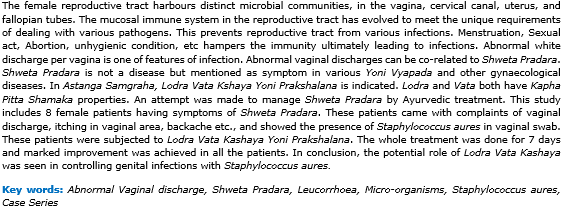A Case Series on Lodra Vata Kashaya Yoni Praskhalana in Shweta Pradara w.s.r. to vaginal infections due to Staphylococcus aures
Keywords:
Abnormal Vaginal discharge, Shweta Pradara, Leucorrhoea, Micro-organisms, Staphylococcus aures, Case SeriesAbstract
The female reproductive tract harbours distinct microbial communities, in the vagina, cervical canal, uterus, and fallopian tubes. The mucosal immune system in the reproductive tract has evolved to meet the unique requirements of dealing with various pathogens. This prevents reproductive tract from various infections. Menstruation, Sexual act, Abortion, unhygienic condition, etc hampers the immunity ultimately leading to infections. Abnormal white discharge per vagina is one of features of infection. Abnormal vaginal discharges can be co-related to Shweta Pradara. Shweta Pradara is not a disease but mentioned as symptom in various Yoni Vyapada and other gynaecological diseases. In Astanga Samgraha, Lodra Vata Kshaya Yoni Prakshalana is indicated. Lodra and Vata both have Kapha Pitta Shamaka properties. An attempt was made to manage Shweta Pradara by Ayurvedic treatment. This study includes 8 female patients having symptoms of Shweta Pradara. These patients came with complaints of vaginal discharge, itching in vaginal area, backache etc., and showed the presence of Staphylococcus aures in vaginal swab. These patients were subjected to Lodra Vata Kashaya Yoni Prakshalana. The whole treatment was done for 7 days and marked improvement was achieved in all the patients. In conclusion, the potential role of Lodra Vata Kashaya was seen in controlling genital infections with Staphylococcus aures.
Downloads
References
Wirth M., Immunology of the genital tract A review 2007;1: 98
Sharma PV, Caraka Samhita of Agnivesha, Reprinted ed. Cikitsasthanam; Yonivyapadchikisita: chapter 30, Varanasi: Chaukhambha Orientalia, 2010;502-34.
Murthy KRS, English translation of Astanga Samgraha of vagbhata. Reprinted ed. Uttrasthana; Guhyarogapratisedha: chapter 39, verse 17. Varanasi:Chaukhambha Orientalia, 2009;347.
Sharma P V, Dravyaguna vijnana vol 2, Varanasi: Chaukhambha Orientalia, 2013; p. 616
Sharma P V, Dravyaguna vijnana vol 2, Varanasi: Chaukhambha Orientalia, 2013;p. 664
Sharma Priyavrut, History of Medicine in India, 2nd edition, 1992, Indian National Science Academy, New Delhi, Pp-527, P No-60-76.
Rampersaud R, Randis T, Ratner A. Microbiota of the upper and lower genital tract. 2012;17(1):51-57.
Staphylococcus aureus - Wikipedia [Internet]. En.wikipedia.org. 20222. Available from: https://en.wikipedia.org/wiki/Staphylococcus_aureus.
Devmurari, V. P. (2010). Antibacterial evaluation and phytochemical screening of Symplocos racemosa Roxb. International Journal of PharmTech Research, 2(2), 1359-1363.
Kumar, G. S., Jayaveera, K. N., Kumar, C. K., Sanjay, U. P., Swamy, B. M., & Kumar, D. V. (2007). Antimicrobial effects of Indian medicinal plants against acne-inducing bacteria. Tropical journal of pharmaceutical research, 6(2), 717-723.
Afzal, T.; Ali, Q.; Malik, A. Phenolic compounds proliferation by HPLC: To find out antibacterial activities in Ficus benghalensis plant extract. Int. J. Botany Stud. 2020, 5, 140–144.
Murti, K.; Kumar, U. Antimicrobial activity of Ficus benghalensis and Ficus racemosa roots L. Am. J. Microbiology. 2011, 2, 21–24.















